
 Actually, this presentation should have been given by Mr. Bozem of W.C. Heraeus. Unfortunately, he called in ill so the presentation was done by Mr. La Greca of IDS Scheer, who has been working with W.C. Heraeus for some years.
Actually, this presentation should have been given by Mr. Bozem of W.C. Heraeus. Unfortunately, he called in ill so the presentation was done by Mr. La Greca of IDS Scheer, who has been working with W.C. Heraeus for some years.
Mr. La Greca first introduced the company W.C. Heraeus, who specialise in precious metals, sensors, dental products, quartz glass, and special light sources. It is a global company with offices in 120 countries. Heraeus products are not available for consumers, but included in many products known from daily life like cell phones, heaters or solar cells.
 The project at Heraeus started 3 years ago. At the beginning, they had a low BPM maturity, for example no KPIs were defined to measure the process performance. They initiated a global BPM program focusing on processes, organisation, and information technology.
The project at Heraeus started 3 years ago. At the beginning, they had a low BPM maturity, for example no KPIs were defined to measure the process performance. They initiated a global BPM program focusing on processes, organisation, and information technology.
In a first phase of 6 months, they developed the BPM concept to be rolled out in the following phases. In the second phase, they introduced the new BPM approach in one country. This took 9-12 months. Currently, they are planning the global roll-out of their BPM program to all countries, which they expect to take at least 18 months.
At the beginning, they defined a mission charter. It states what should be achieved. Personally, I would call that a vision statement. Along those initial efforts, they define roles with a distinction between cross-functional and internal roles. The new BPM structure was added to the existing organisational structure, not throwing away what already works.
They came up with a systematic clarifying the responsibility of each process owner. They distinguish global processes, division and business unit specific processes, and location/country specific processes. Depending on the process type, different responsibilities are assigned to a process owner.
To explain BPM to Heraeus employees, they used a soccer metaphor. Of course all employees are great, but they need to learn to play together. In addition, playing together is not enough, but you must structure your playground (defence, mid field, offense). Of course in BPM you don't distinguish in defence and offense, but for example in value-adding processes and supporting processes. Mr. La Greca emphasised that the soccer metaphor was an important tool to communicate the idea to all employees.
From there, they continued with the following steps:
- align organisation to BPM
- translate BPM to operational terms
- executive leadership
- make BPM a continual process
- make BPM everyone's job
Aligning the organisation was done in ARIS by capturing all users and modelling their responsibilities. They also used a tool they called BPM process cards. Basically, it is a RASCI chart. They defined such cards for different use cases like rolling out a new process or deciding on change requests. The card shows for a specific user how he is involved in each scenario. In the end, there were about 10 scenarios they described.
At the end, there was a question and answer session. One participant asked about the number of processes designed. They revealed 14 major business scenarios like financing and sales. Below, there are about 50 end-to-end scenarios boiling down to about 300 processes. Those processes were documented in about 6 months (initial phase, see above).
Another participant asked how it is ensured that local changes are considered in the process templates if they are rolled out globally? Mr. La Greca answered that guidelines were put in place describing what could be changed locally and which parts could not be negotiated, but must be implemented strictly.
Of course, people were interested in the KPIs they gathered to document the BPM approach. Basically, they are measuring the performance of the 14 major business scenarios. For example, in supply chain management they are measuring delivery time. All KPIs are linked to a balanced scorecard available to top management.
Another easy question was if they got top management buy-in from the beginning? The answer was yes. Mr. La Greca added that they would not start such a big project without top management support, because it would be bound to fail.
Finally, a participant asked how they got the buy-in of employees for the BPM program? Here, Mr. La Greca pointed again to the point executive leadership. Communicating the benefits of the program to the employees was a task of the senior management team. For example, they put up a clear roadmap, had frequent meetings with stakeholders and showed improvements early.
Personally, I love this kind of presentation, because they clearly show that it is possible to implement BPM and that it actually works in practice. Of course there is more to it than what can be shown in a presentation, but I guess participants can take one or two interesting ideas home to make their BPM project more successful.











